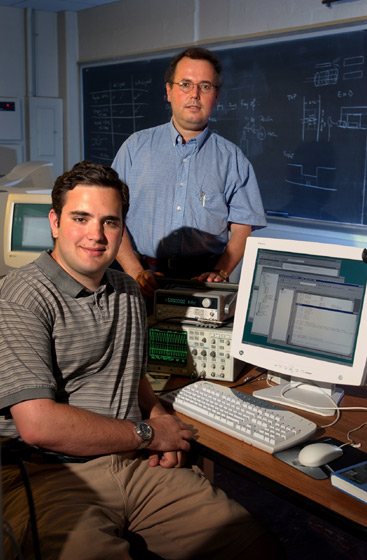Peter Susi ’03 (Unionville, Conn.), a double major in electrical and computer engineering and economics and business, is trying to fix “packet loss” — the short breaks, broken phrases, or silences in audio content that Internet users experience during a transmission.
A participant in Lafayette’s EXCEL Scholars program, Susi is working on campus with Ismail Jouny, associate professor of electrical and computer engineering. In EXCEL, students collaborate with faculty on research while earning a stipend.
“Data loss or delays over the Internet are common when streaming audio,” explains Jouny. “We’re usually not as bothered by the loss of images, but loss of sound can be annoying. Audio is essentially coming in from several places in several packets of data. Sometimes when you are streaming audio from the Internet using RealPlayer or WindowsMedia Player, some of the packets of data or sound are lost. We’re trying to find out what is lost by creating a packet loss recovery system. Through this system, we hope to predict and replicate what the speaker would transmit.”
“We’re looking into the possibility of using a neural network to fill in the missing packets,” says Susi. “We’re also experimenting with probabilities and random-process techniques to replace bits that tend to exhibit a pattern.”
Methods for avoiding data loss or silences during an audio transmission vary. Susi is examining the missing pieces of the puzzle and filling in gaps based on the information that he and Journy have received. He is then encoding the data using a method called Linear Prediction Coding, which encodes audio represented in a binary format and allows one to predict what a speaker would transmit within the confines of less than a word.
“It sounds impressive, but it’s remarkably simple in concept,” he says.
Susi enjoys the challenges of his research and particularly likes that he’s building his computer skills by using new hardware and software.
“I tried EXCEL because I’m looking to broaden my research experience,” he says. “I’ve spent three summers working at a local engineering firm near my home in Connecticut and have experienced the many facets of the engineering world — development, testing, customer specifications, quality control — but never really got into research of new ideas.”
Susi is particularly pleased with his partnership with Jouny.
“I went into this project after knowing Professor Jouny for three semesters,” he says. “He’s had me in class all this year, and we’ve developed a good working relationship. I’d say Lafayette far exceeds any school where I need to compete with a graduate student, or I’m taught by a [teaching assistant] most of the time. Professor Jouny’s door is always open, and I’ve gone to him with questions many times, both before this summer and now.”
Susi is a member of Omicron Delta Epsilon, the national honor society for the study of economics; Eta Kappa Nu, the honor society for electrical engineering; Institute of Electrical and Electronics Engineers; and Society of Women Engineers. A college network center technician, Susi performs in Pep Band and participates in varsity fencing.

Filling gaps in Internet sound transmissions was the focus of EXCEL research by Peter Susi ’03 and Ismail Jouny, professor of electrical and computer engineering.
